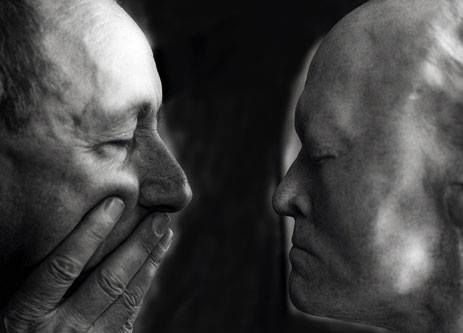|
__________
No.
1
Drawings,
paintings
&
essay
No.
3
Drawings
No.
9
Drawings
Anthology
Curator
Aquarum
Drawings
&
tribute
|
_______________________________________________

Dennis and Mr Blake. Photograph taken by
Steve Creffield in 2015.
Dennis Creffield (29 January 1931 – 26 June 2018) was a British
artist with work owned by major British and worldwide art
collections, including the Tate Gallery, The British Museum, Arts
Council of England, the Government Art Collection, The Los Angeles
County Museum of Art, Leeds City Art Gallery, Williams College
Museum of Art and many others.
Read the Wikipedia article here: https://en.wikipedia.org/wiki/Dennis_Creffield
|
Peter Ackroyd on Dennis Creffield
FORM AND FABRIC
“To them Howards End was a house;” E. M. Forster wrote,
“they
could not know that to her it had been a spirit, for
which she sought a
spiritual heir.” Of course those spirits are around us
still, and the
testimony both of English art and English literature
confirms that the
house, the church, even the smallest dwelling place,
represents the
eternal transaction between man and earth. Dennis Creffield
is part of
that tradition and all of his work affirms what used
to be called genius
loci, but which can be less mythologically rendered as
the spirit of place.
His wonderful drawings of the English cathedrals, for
example,
displayed his veneration for those great bodies of stone
– “body” being
the appropriate word here since, as he himself explained,
he was intent
upon “the reconciling of geometry with the organic”.
These vast fabrics
of stone live again in his charcoal drawings, and in
so doing emphasize
an important truth – that to have a sense of place is
also to have a sense
of history. The artist stands before the great churches
and, in that
moment when he reveals their instantaneous shape upon
paper, he
becomes part of a larger process; to paraphrase the German
mystic,
Jacob Boehme, he disclose time in eternity, as well as
eternity in time.
Dennis Creffield is in that sense
part of a continuing inheritance,
and it is intriguing to learn that he sketched inside
Westminster Abbey
when he was a young man. This was also the site of William
Blake’s
apprenticeship, and we can see in Creffield’s work the
same instinct
towards a religious, almost a medieval, vision. But he
is also attached
to a more accessible English tradition; there are artists
like Cotman,
Girtin, Cozens and Constable, who have been drawn to
the qualities
of stone, to the textures of houses, to the surfaces
of cathedrals, to the
harmonies of a building in a landscape. Creffield can
also be seen as
part of the antiquarian tradition in England, which itself
leads back to
the great Gothic builders of our race and eventually,
perhaps, to the
masons of Stonehenge who made stone their god and therefore
saw
God in the stone.
But this is to stretch history
into legend, when there are far more
important resemblances closer to hand. Dennis Creffield’s
paintings
of Petworth and its park may be seen on one level as
a “homage” to
Turner, but only in the spirit that animates all of Ceffield’s
work – that
the artist’s vision is a collaboration between past and
present, between
the living and the dead painter. The great floods of
colour and the
bright tonality continue Turner’s own fantastic ceremonies
of light, but
in Creffield’s painting there is always the sense of
the house and its land
as organic, breathing forms. In his recent drawings of
Brimham Rocks
he demonstrates his affinity with the very texture of
the earth, and in
these paintings of Petworth he reveals the same concern
for form and
for fabric – the form of the house, the form of the land,
the form of that
moment when house and land meet to become an expression
of the
same spirit. That is why his paintings of Petworth Park
are filled with
a sense of the English landscape – their rhythms, their
gentle curves,
their luminosity, express an almost religious fervour.
They are, in the
proper sense, a revelation.
Yet this need not be a solemn
or portentous undertaking, and in
Creffield’s paintings there is a great vivacity combined
with
exuberance; he becomes one with the fabric of the house
or the land,
and so can reveal its permanence in that moment of celebration
when
he puts paint upon the canvas. Note, in particular, how
he manages to
convey that light which seems to surround the old house;
it is as if time
were accustomed to it, and rested a little. So we return
to Howards
End and the house as “spirit”. Dennis Creffield has himself
quoted
Wittgenstein’s aphorism that architecture “expresses
a thought”. It is
the triumph of these paintings that, here, the spirit
and the thought are
so beautifully aligned.
Peter Ackroyd, London, 1993
From the catalogue
Dennis Creffield - PAINTINGS OF PETWORTH,
Gillian Jason Gallery, London.1993
|
_________

CURRENT
|


![]() © 2003-2018 Ars Interpres Publications.
© 2003-2018 Ars Interpres Publications.